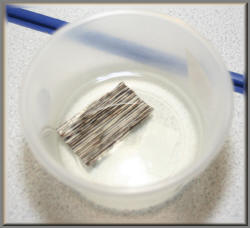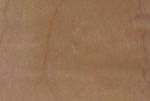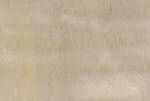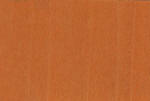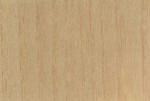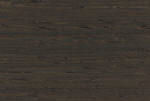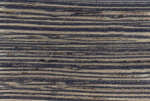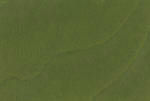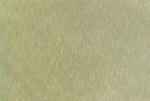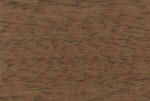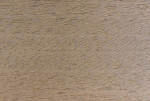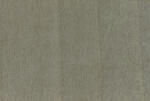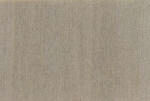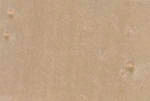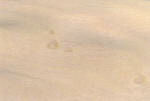|
Bleaching and Lightening Veneers by Alf Murtell |
|
|
"This evening’s demonstration is bleaching. My first words of caution to you are, when using undiluted bleach – no dipping your hands into the bleach, wear gloves if necessary, or use tweezers to pick the bits of veneer out – watch your clothing, watch your carpet! And that advice is straight forward of course. Not all woods are easy to bleach, I’ve done some in advance which I’ll pass round to you, you'll see the normal veneer and then the bleaching that’s taken place – there’s also one there with dyed veneers. I’ve had to start it off a little earlier this evening, because it takes approximately three hours for the bleaching to take effect – so I did some at home first and I’ve emptied the bleach back again because of having to carry it, but it’s already started working again. There is some ‘Wenge’ that's taken a good effect |
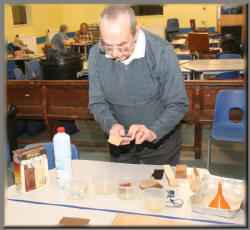 |
|||||||||||||||
|
|
Question: “I presume Alf that being a hard wood it takes a bit longer for the bleach to take effect?” “Approximately three hours
it takes to be on the safe side” Question: “do you soak your veneer first before you place it in the bleach?” “no, just cut your veneer up to the piece that you want and put it in the bleach for about three hours – some you’ll find will take less than three hours, but to be on the safe side, say three hours – |
|||||||||||||||
|
no longer though, don’t put it in
over night, it’s not necessary” Question: “do you use it diluted or undiluted?” “oh, undiluted” Sapele, although now I’ve said how long it takes, the Sapele has not started working yet. If you have a look at that sheet I’ve passed round you’ll see that the Sapele has come out really white. It’s not taken effect yet, but it will do if we give it a bit longer – and Bird’s Eye Maple, this is coming up very white, |
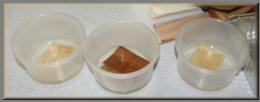 Three pieces in the bleach solution |
|||||||||||||||
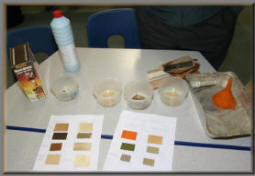 A view of the equipment required for performing the bleaching process |
Question: “Alf, we know that Holly and Chestnut are nice white woods, in your experience can you get any of these woods to come up whiter than that?” “Well, this is why it’s come about, Maple when it’s bleached will come up really white” “yes but that example's still a bit on the yellowy side” “Well, the snag was that I’ve had to stop the bleaching in order to carry it, then I’ve had to start all over again, but if you have a look at that sheet – well, there’s the Maple and there’s the Bird’s Eye – they come out really white” But all this that you’ve been bleaching, you must put it under a running tap with running water and wash the bleach out and put it in between paper towels with a weight on top and leave it over night. So don’t attempt to do it without washing the bleach out because it may affect your picture and the polishing, alright? Question: “how long do you run it under the tap for?” “only two or three minutes, let the water run round it back and front, then put it in between paper towels – don’t put it in between news print will you? Because you’ll get print on it! |
|||||||||||||||
|
Question: “does the wood absorb the bleach at all?” “I’ve tried doing plenty of woods, but you don’t always have a lot of success with it, especially with white woods where it doesn’t really have much effect on it at all – and once the bleach has been washed out I haven’t noticed any evidence of it being retained in the wood” The main thing is don’t leave it in the bleach over night – in fact Roy here did some bleaching and he left it over night, and when he came up the next morning it had all turned to a cellulose jelly! Question: “do you use a very strong bleach Alf?” “actually it’s just Sainsbury’s normal bleach – I recommend it, yes Sainsbury’s!” Right, well the next bleaching product is Rustin’s – this is a two bottle item and is only suitable for solid timber – the reason for it is you have to wash the wood well after you’ve applied the bleach and the other contents. |
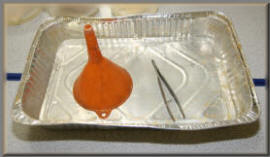 Using
these tools and container |
|||||||||||||||
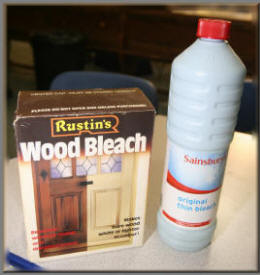
The two types of bleach used
for |
If you had the veneer stuck onto a table top it will start lifting, so you cannot use it on a table top that’s been veneered, it’s got to be solid timber There are precautions you’ve got to take when using this, the same the other – which I’ll go over when we get near the end of this demonstration I’ve bleached some various woods here mahogany, beech, sapele, cherry, pine, oak and walnut. Question: “I suppose it depends on the density of the wood on how far that can go into it?” “I think, to be quite honest, it will only affect the top surface – although it says on the side here ‘removes weather stains and discolouration’ so in other words it’s a ‘cleaner and stain remover’ – I mean, you wouldn’t expect to see a door like that, but anyhow, it’s only really meant for the top surface for bleaching” Whilst I’m talking about it I’ll mention one or two things here: you put on bleach “A” with a brush, let it dry, and after 20 minutes or so, then apply bleach “B” and that’ll take about three hours to work. The point to consider now is the wood should be washed with a solution containing one teaspoonful of acetic acid (that’s white vinegar) in one pint of water – so these are the sort of preparations you’ve got to make. If Rustin’s Plastic Coating is to be applied after bleaching, wash the surface with a solution of spirits of salts (Hydrochloric acid) and water using one part of spirits of salts to seven parts of water. Now I don’t know if you know, but spirits of salts is a deadly stuff to work with – you get vapours from it and you can’t afford to take any chances with it, so if you’re going to use it make sure that you use it in that proportion of one part of salts to seven parts of water. |
|||||||||||||||
|
This is a piece of Wenge that I used with Rustins – it’s come out virtually the same as it did when I used household bleach, it’s not much difference on it Question: “what’s the difference in the price?” “well, this pack costs around £11. 50 so, unless you’ve got a table that you want to renovate then it’s worth the expense, but my opinion is that it’s probably not worth it for our needs” Question: “do you wash it with water again?” “yes you must wash it with water first of all, then if necessary you then neutralise it with acetic acid – that’s white vinegar, okay? – and then carry on as normal applying a dye or whatever you want, bringing it back to the colour you require, but if you are going to use Rustins Plastic Coating, then you are going to have to use spirits of salts on it, you must use that. But I don’t know how you’re going to get hold of spirits of salts these days as before it wasn’t very easy (interruption: surely it would eat the wood away?) yes indeed, it is very deadly stuff! It would take the stains out of anything it would, (interruption: so that’s alright for taking the ring stains out of tables and other furniture) yes indeed, even ink stains or anything like that – perhaps weather stains, but in my opinion it has limited use for marquetry because, unless you’re going to renovate a table top that you’re very proud of and you think “well I must get all these stains off” then yes, use these kits, but if it’s been veneered (this table top), then you cannot use these (kits) |
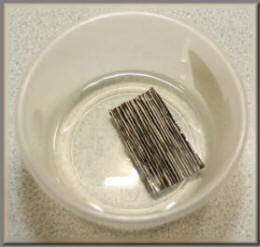 A piece of
Wenge in the Rustin's |
|||||||||||||||
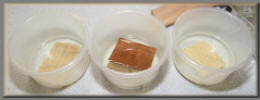
The test veneers after
soaking in the bleach |
because you’ve got to wash it down well once you’ve applied these and if it’s veneered it’ll start bubbling and your table top might – well hhmm, yes, so it’s a solid timber project entirely I'm afraid. Question: “you couldn’t actually do a table top with common bleach without taking a risk” “yes, you’ve got to get all the old polish off, you’ve got to sand it down “ “no, I mean if it’s veneered” “no, if it’s veneers on a table top then you can’t wash it down, but this is ideal for table tops of solid timber” Question: “what about coloured woods Alf?” “the bleaching of coloured veneers like you’ve got there takes about half an hour, because as you know, it’s all sycamore and putting the bleach on that it works within half an hour easily (it just gives you a lighter shade doesn’t it?) yes indeed. |
|||||||||||||||
|
On the question of dyed veneers, I know that some of you have only just recently started marquetry, but take care because the strong colouring in them can upset your picture – the colour can be too strong, but there’s nothing to stop you from using dyed veneers, by all means use them, but I mean it’s your picture, use them, but they can be a bit garish in the layout of the picture, but if you want to use say a red, ask someone ‘what do you think about using a red here?’ and they will advise you about using a red or another type of veneer, but by all means use dyed veneers if you want to use them Question: “are there any woods that wouldn’t take the bleach?” “not that I know of, no, I think you’ll find that all woods would take it, but there is one wood that will not take it, I’m glad you mentioned that, American Blackwood, it’s as black as Newgates Knocker, no that doesn’t take it – you can see where I’ve tried it. I don’t know what the wood really is, I know it’s called American Blackwood, I thought it was black American Walnut, but I don’t think it is. |
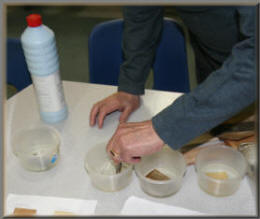 Alf shows us the safe method of inserting veneers into the bleach |
|||||||||||||||
|
(could they get a veneer off of that?) oh I expect they could, although black American Walnut is from the bark of the tree and I was just wondering if that’s a piece of black American Walnut, but short of taking it and putting it under a microscope there’s no way of saying. That’s a solid piece there – a strong piece of timber – in fact I was trying to use the bleach on it to see what would happen but it’s so strong it wasn’t affected. Question: “Alf, if you’re dying a piece of wood do you leave it in for three hours?” “no, I’ve never tried dying veneers, it’s a bit of a tricky problem, I’ll tell you what the problem is, you put it in a solution of blue or whatever it is, and leave it for three hours – or leave it overnight, take it out, and if you split it open you’ll find it has not penetrated the veneer, it’s white in the middle still, so I would not recommend trying to dye veneers. The only dyed veneers I would recommend are the harewoods – which are dyed sycamore – from a white to a grey, a bluish grey. Any other questions? No, well thanks for attending this demonstration, please enjoy the rest of the evening." End of demonstration. |
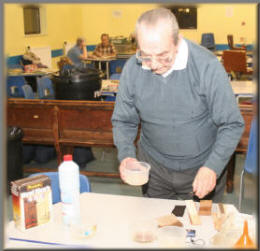 Alf inserts the veneer pieces into the bleach |
|||||||||||||||
|
|
||||||||||||||||
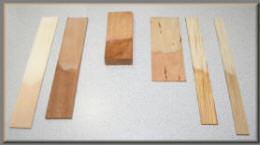 Six examples of pieces of veneer that have been bleached along 50% of their length |
In the photograph on the left you
can see six examples of pieces of different veneers that
have been bleached for about 50% of their length.
To bleach them in this fashion they were stood on their end in a container of bleach. They are, from left to right: As you will note: the mid tones work best. The tables below show you the changes you can achieve with 3 hours bleaching |
|||||||||||||||
|
||||||||||||||||
| Tutorials Menu | ||||||||||||||||


